《跨境电子商务实用英语》全套教学课件1-3 Cross - border E-commerce Development in China
- 格式:pptx
- 大小:767.43 KB
- 文档页数:33


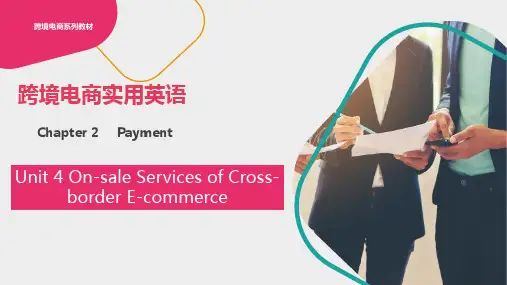
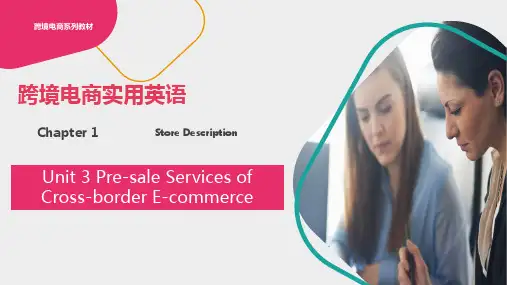
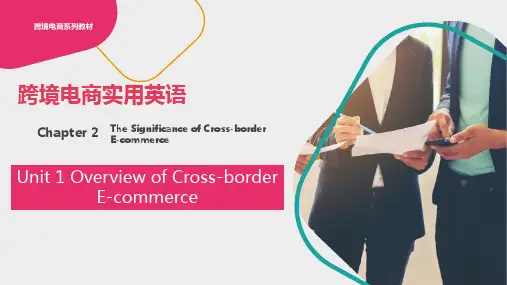
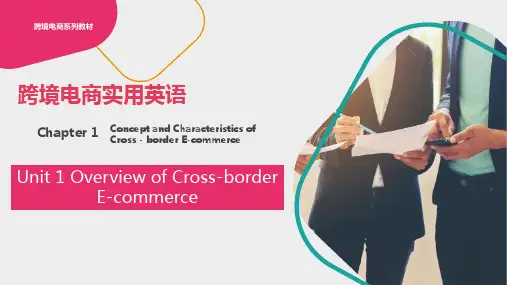
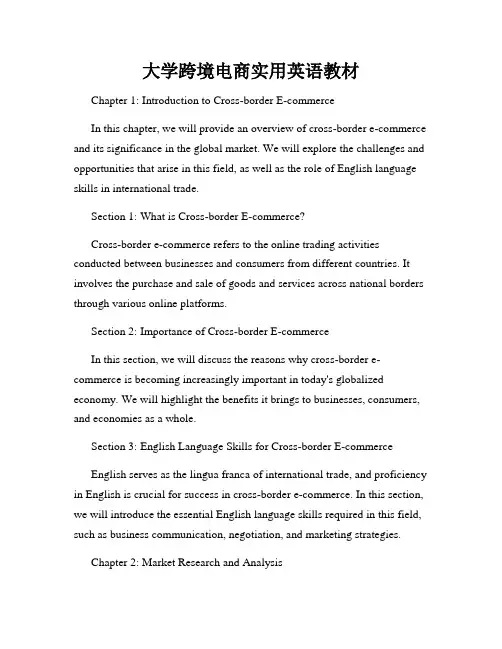
大学跨境电商实用英语教材Chapter 1: Introduction to Cross-border E-commerceIn this chapter, we will provide an overview of cross-border e-commerce and its significance in the global market. We will explore the challenges and opportunities that arise in this field, as well as the role of English language skills in international trade.Section 1: What is Cross-border E-commerce?Cross-border e-commerce refers to the online trading activities conducted between businesses and consumers from different countries. It involves the purchase and sale of goods and services across national borders through various online platforms.Section 2: Importance of Cross-border E-commerceIn this section, we will discuss the reasons why cross-border e-commerce is becoming increasingly important in today's globalized economy. We will highlight the benefits it brings to businesses, consumers, and economies as a whole.Section 3: English Language Skills for Cross-border E-commerceEnglish serves as the lingua franca of international trade, and proficiency in English is crucial for success in cross-border e-commerce. In this section, we will introduce the essential English language skills required in this field, such as business communication, negotiation, and marketing strategies.Chapter 2: Market Research and AnalysisEffective market research and analysis are fundamental for successful cross-border e-commerce. This chapter will guide students on how to conduct market research and analyze data to make informed business decisions.Section 1: Market Research MethodsHere, we will introduce various market research methods, including surveys, interviews, and data analysis. Students will learn how to identify target markets, assess consumer demands, and evaluate competitors in different countries.Section 2: Data Analysis TechniquesIn this section, students will learn how to analyze market data using statistical tools and software. We will cover topics such as data visualization, trend analysis, and forecasting methods.Section 3: Case StudiesTo provide practical insights, this section will include case studies of successful cross-border e-commerce companies. Students will learn from real-world examples and understand how market research and analysis contribute to their success.Chapter 3: International Marketing StrategiesIn this chapter, we will explore various marketing strategies and techniques specific to cross-border e-commerce. Students will gain knowledge on how to adapt marketing strategies to different cultures and target international consumers effectively.Section 1: Cultural Considerations in International MarketingCultural differences play a significant role in international marketing. In this section, we will discuss the importance of cultural awareness and how to tailor marketing messages to different cultural contexts.Section 2: Digital Marketing ChannelsWe will introduce the digital marketing channels commonly used in cross-border e-commerce, including social media, search engine optimization, and content marketing. Students will understand how to leverage these channels to maximize their reach and brand exposure.Section 3: Localization and TranslationAdapting websites, product descriptions, and marketing materials to the local language is crucial in international marketing. This section will provide guidance on localization strategies and the importance of accurate translation.Chapter 4: Regulatory and Legal EnvironmentTo engage in cross-border e-commerce successfully, it is essential to understand the regulatory and legal framework governing international trade. This chapter will cover the key regulations and legal considerations in cross-border e-commerce.Section 1: International Trade RegulationsHere, we will introduce students to international trade regulations, including customs duties, trade barriers, and intellectual property rights protection. Students will learn how to navigate these regulations and ensure legal compliance.Section 2: E-commerce Laws and Privacy ProtectionAs cross-border e-commerce involves the online exchange of personal information, it is crucial to understand e-commerce laws and privacy protection measures. This section will cover topics such as data protection, cybersecurity, and consumer rights.Section 3: Dispute ResolutionIn this section, students will learn about dispute resolution mechanisms in cross-border e-commerce, such as negotiation, mediation, and arbitration. They will understand the importance of resolving disputes efficiently to maintain business relationships.ConclusionThis practical English language textbook provides students with comprehensive knowledge and skills necessary for success in the field of cross-border e-commerce. Whether students aspire to become entrepreneurs or work in international trade, this textbook equips them with the tools needed to navigate the global marketplace. Through in-depth analysis, case studies, and practical guidance, students will develop a solid foundation in cross-border e-commerce and enhance their English language proficiency.。
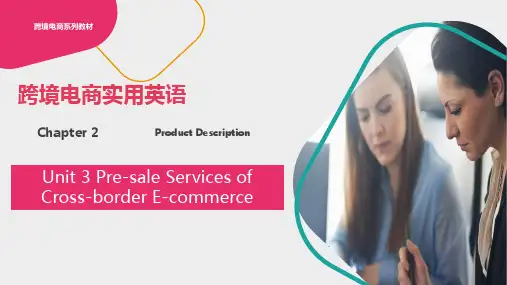
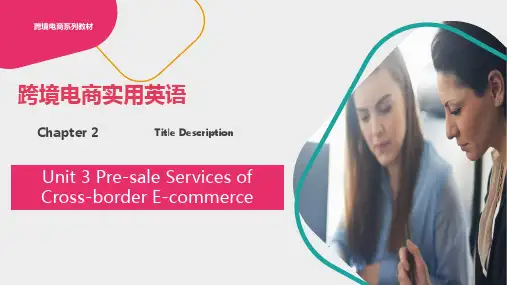
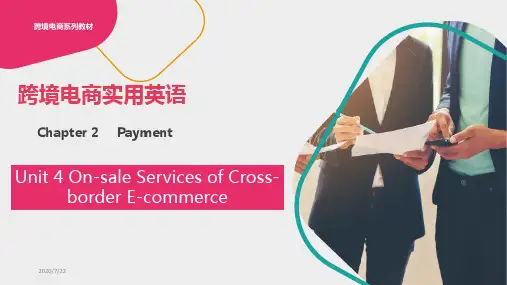

外研社2023跨境电商交际英语(修订版)教学课件unit3外研社2023跨境电商交际英语(修订版)教学课件 Unit 3In recent years, with the rapid development of the internet and technology, cross-border e-commerce has become increasingly popular. In this unit, we will focus on the topic of cross-border e-commerce and learn how to effectively communicate in English within this field.1. Introduction to Cross-border E-commerceCross-border e-commerce refers to the online trading activities between businesses and consumers across different countries. It enables businesses to expand their market reach globally and consumers to access a wider range of products. It involves various aspects such as international logistics, customs regulations, and payment methods.2. Key Vocabulary and Expressions2.1 E-commerce Terminologies:- Online marketplace: a digital platform where businesses and consumers can buy and sell products.- Order fulfillment: the process of receiving, processing, and delivering customer orders.- Inventory management: the control and tracking of stock levels to ensure availability of products.- Customer satisfaction: the measure of how well a company's products and services meet or exceed customer expectations.- Return policy: the rules and procedures for customers to return purchased goods.2.2 Payment Methods:- Credit card: a plastic card issued by a bank, allowing the cardholder to make purchases with a line of credit.- PayPal: an online payment platform that enables individuals and businesses to make secure transactions.- Alipay: a popular third-party online payment platform in China.3. Effective Communication in Cross-border E-commerce3.1 Writing Professional Emails:When engaging in cross-border e-commerce, it is important to write professional and concise emails. Here are some tips for effective email communication:- Use a clear and descriptive subject line.- Start with a polite greeting and introduction.- Clearly state the purpose of the email and provide necessary details.- Use a professional tone and avoid using slang or abbreviations.- Provide contact information for further inquiries or follow-ups.- End the email with a polite closing remark.3.2 Negotiating and Bargaining:Negotiations and bargaining are common in cross-border e-commerce. Here are some useful phrases for negotiating:- Could you offer a discount if we place a larger order?- We would like to negotiate the price/terms.- Is there any room for negotiation?- What is your best offer?- Can we find a middle ground?4. Cross-cultural Considerations4.1 Understanding Cultural Differences:Cross-border e-commerce involves interactions with people from different cultures. It is important to be aware of cultural norms and practices to avoid misunderstandings. For example, in some cultures, it is customary to negotiate extensively before reaching an agreement, while in others, price negotiations may be considered rude.4.2 Adapting to Local Market Preferences:When expanding cross-border, it is crucial to adapt your product offerings and marketing strategies to suit local market preferences. This includes understanding the target audience, their needs, and preferences. Conducting market research and collecting feedback from local customers can help make informed decisions.5. ConclusionIn this unit, we have explored the topic of cross-border e-commerce and learned how to communicate effectively within this field. By mastering the key vocabulary, expressions, and communication skills, you will be well-equipped to navigate the complex world of cross-border e-commerce and engage in successful business transactions.Remember, effective communication is the key to building trust and establishing long-term relationships with international business partners. Keep practicing and honing your communication skills to excel in cross-border e-commerce.。
跨境电子商务英语unitcrossborderecommercepaymentxx年xx月xx日CATALOGUE目录•跨境电子商务简介•跨境电子商务支付概述•跨境电子商务支付流程•跨境电子商务支付的支付安全•跨境电子商务支付的案例分析•跨境电子商务支付的未来趋势01跨境电子商务简介Cross-border electronic commerce (Cross-border e-commerce): the electronic commerce activities that involve the purchase, sale, or transfer of goods or services between different countries or regions The transaction object may involve cross-border trade, but the transaction itself is still within the scope of domestic commerceThe continuous growth of global e-commerce transactions and the increasing popularity of cross-border e-commerce have jointly promoted the rapid development of cross-border e-commerce With the continuous maturity of technology and infrastructure, cross-border e-commerce has gradually become an important part of global e-commerceEstablish a factory or production base in the target market to carry out production activities and sales activities locally Establish a cross-border logistics distribution center to provide cross-border logistics services and distribution services for enterprisesDirect foreign in…Cross-border e-co…Cross-border logi…02跨境电子商务支付概述跨境电子商务支付的定义•Cross-border electronic commerce payment refers to the payment solutions and services provided by financial institutions or non-financial institutions for cross-border电子商务交易activities, which cover a wide range of fields such as import and export trade, overseas investment, offshore funds, and tourism.Electronic remittance Credit cardPayPalConvenient SecureThe cross-border electronic commerce paymentis secure. It ensures the security of funds byencrypting sensitive information such as accountnumbers and passwords.03跨境电子商务支付流程客户选择心仪的商品并提交订单。